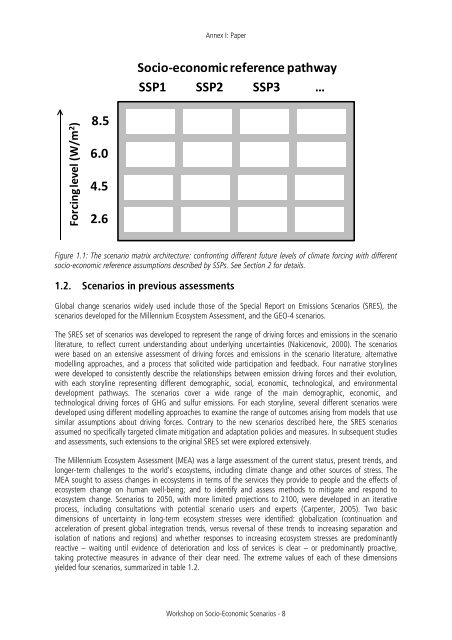Workshop Report - IPCC
Workshop Report - IPCC
Workshop Report - IPCC
You also want an ePaper? Increase the reach of your titles
YUMPU automatically turns print PDFs into web optimized ePapers that Google loves.
Annex I: Paper<br />
Socio‐economic reference pathway<br />
SSP1 SSP2 SSP3 …<br />
Forcing level (W/m 2 )<br />
8.5<br />
6.0<br />
4.5<br />
2.6<br />
Figure 1.1: The scenario matrix architecture: confronting different future levels of climate forcing with different<br />
socio-economic reference assumptions described by SSPs. See Section 2 for details.<br />
1.2. Scenarios in previous assessments<br />
Global change scenarios widely used include those of the Special <strong>Report</strong> on Emissions Scenarios (SRES), the<br />
scenarios developed for the Millennium Ecosystem Assessment, and the GEO-4 scenarios.<br />
The SRES set of scenarios was developed to represent the range of driving forces and emissions in the scenario<br />
literature, to reflect current understanding about underlying uncertainties (Nakicenovic, 2000). The scenarios<br />
were based on an extensive assessment of driving forces and emissions in the scenario literature, alternative<br />
modelling approaches, and a process that solicited wide participation and feedback. Four narrative storylines<br />
were developed to consistently describe the relationships between emission driving forces and their evolution,<br />
with each storyline representing different demographic, social, economic, technological, and environmental<br />
development pathways. The scenarios cover a wide range of the main demographic, economic, and<br />
technological driving forces of GHG and sulfur emissions. For each storyline, several different scenarios were<br />
developed using different modelling approaches to examine the range of outcomes arising from models that use<br />
similar assumptions about driving forces. Contrary to the new scenarios described here, the SRES scenarios<br />
assumed no specifically targeted climate mitigation and adaptation policies and measures. In subsequent studies<br />
and assessments, such extensions to the original SRES set were explored extensively.<br />
The Millennium Ecosystem Assessment (MEA) was a large assessment of the current status, present trends, and<br />
longer-term challenges to the world’s ecosystems, including climate change and other sources of stress. The<br />
MEA sought to assess changes in ecosystems in terms of the services they provide to people and the effects of<br />
ecosystem change on human well-being; and to identify and assess methods to mitigate and respond to<br />
ecosystem change. Scenarios to 2050, with more limited projections to 2100, were developed in an iterative<br />
process, including consultations with potential scenario users and experts (Carpenter, 2005). Two basic<br />
dimensions of uncertainty in long-term ecosystem stresses were identified: globalization (continuation and<br />
acceleration of present global integration trends, versus reversal of these trends to increasing separation and<br />
isolation of nations and regions) and whether responses to increasing ecosystem stresses are predominantly<br />
reactive – waiting until evidence of deterioration and loss of services is clear – or predominantly proactive,<br />
taking protective measures in advance of their clear need. The extreme values of each of these dimensions<br />
yielded four scenarios, summarized in table 1.2.<br />
<strong>Workshop</strong> on Socio-Economic Scenarios - 8

















